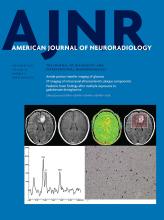Research ArticleInterventional
Influence of Carotid Siphon Anatomy on Brain Aneurysm Presentation
E. Waihrich, P. Clavel, G.A.C. Mendes, C. Iosif, I. Moraes Kessler and C. Mounayer
American Journal of Neuroradiology September 2017, 38 (9) 1771-1775; DOI: https://doi.org/10.3174/ajnr.A5285
E. Waihrich
aFrom the Department of Interventional Neuroradiology (E.W., P.C., G.A.C.M., C.I., C.M.), Dupuytren University Hospital, Limoges, France
bDepartment of Neurosurgery (E.W., I.M.K.), Universidade de Brasília, Brasília, DF, Brazil.
P. Clavel
aFrom the Department of Interventional Neuroradiology (E.W., P.C., G.A.C.M., C.I., C.M.), Dupuytren University Hospital, Limoges, France
G.A.C. Mendes
aFrom the Department of Interventional Neuroradiology (E.W., P.C., G.A.C.M., C.I., C.M.), Dupuytren University Hospital, Limoges, France
C. Iosif
aFrom the Department of Interventional Neuroradiology (E.W., P.C., G.A.C.M., C.I., C.M.), Dupuytren University Hospital, Limoges, France
I. Moraes Kessler
bDepartment of Neurosurgery (E.W., I.M.K.), Universidade de Brasília, Brasília, DF, Brazil.
C. Mounayer
aFrom the Department of Interventional Neuroradiology (E.W., P.C., G.A.C.M., C.I., C.M.), Dupuytren University Hospital, Limoges, France

References
- 1.↵
- 2.↵
- King JT Jr.
- 3.↵
- Takeuchi S,
- Karino T
- 4.↵
- 5.↵
- Malek AM,
- Alper SL,
- Izumo S
- 6.↵
- 7.↵
- 8.↵
- Lin LM,
- Colby GP,
- Jiang B, et al
- 9.↵
- 10.↵
- 11.↵
- 12.↵
- Allison PD
- 13.↵
- Hosmer DW,
- Lemeshow S
- 14.↵
- Brisman JL,
- Song JK,
- Newell DW
- 15.↵
- Thomas JB,
- Antiga L,
- Che SL, et al
- 16.↵
- Jou LD,
- Lee DH,
- Morsi H, et al
- 17.↵
- 18.↵
- Piccinelli M,
- Bacigaluppi S,
- Boccardi E, et al
- 19.↵
- Lauric A,
- Safain MG,
- Hippelheuser J, et al
In this issue
American Journal of Neuroradiology
Vol. 38, Issue 9
1 Sep 2017
Advertisement
E. Waihrich, P. Clavel, G.A.C. Mendes, C. Iosif, I. Moraes Kessler, C. Mounayer
Influence of Carotid Siphon Anatomy on Brain Aneurysm Presentation
American Journal of Neuroradiology Sep 2017, 38 (9) 1771-1775; DOI: 10.3174/ajnr.A5285
0 Responses
Jump to section
Related Articles
- No related articles found.
Cited By...
- No citing articles found.
This article has not yet been cited by articles in journals that are participating in Crossref Cited-by Linking.
More in this TOC Section
Similar Articles
Advertisement











